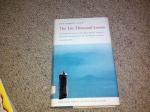|
This section contains 4,010 words (approx. 14 pages at 300 words per page) |

|
SOURCE: Putzar, Edward. “The Man'yōshū.” In Japanese Literature: A Historical Outline, pp. 27-35. Tucson: University of Arizona Press, 1973.
In the following excerpt, Putzar traces the development of the Man'yōshū over four periods ranging from 629 to 759 and surveys the collection's principal poetic contributors.
The Gi; the man'yōshū =~ Sman'yōshū
The twenty scrolls of the Man'yōshū record approximately 4,500 poems. In addition to the dominant forms of chōka and waka there are sixty-two sedōka, one poem in the Buddha's footprint-stone poems form (bussokuseki katai), and one linked verse (renga). The Man'yōshū was not compiled as a unified whole and there is some diversity in its editorial style. Basically the poems fall into three types: miscellaneous (zōka), love poems (sōmonka), and elegies (banka). Further classification can also be made through differentiating poems that are direct statements of emotion, those which dwell on some...
|
This section contains 4,010 words (approx. 14 pages at 300 words per page) |

|


